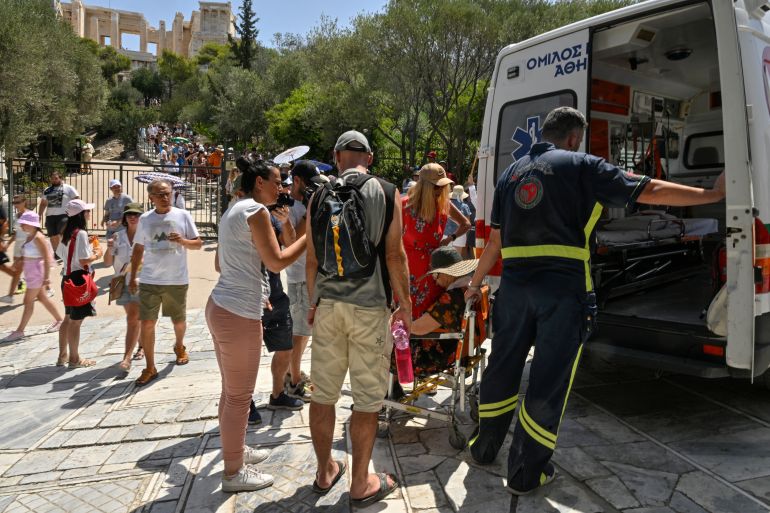Did climate change cause 16,500 extra deaths in Europe this summer?
Study covering 854 European cities finds that officially reported heat deaths remain ‘significantly underestimated’.

By Ted Regencia
Published On 17 Sep 202517 Sep 2025
Save
This summer was one of the hottest on record in Europe, with temperatures soaring above 46 degrees Celsius (114 degrees Fahrenheit), triggering wildfires and causing the deaths of thousands of people, particularly among the elderly.
Climate change is likely to be responsible for 68 percent, or about 16,500, of additional heat-related deaths, according to new research from the Grantham Institute – Climate Change and the Environment in London, United Kingdom.
This is partly because rising temperatures triggered by human-caused climate change are the main cause of the intense wildfires that ravaged parts of the continent this year. Four times as much land area as the usual annual average was burned in Spain at 380,000 hectares (940,000 acres) – more than five times the size of Singapore. In Portugal, 280,000 hectares (690,000 acres) of land was burned – larger than the area of the country of Luxembourg and two-and-a-half times the annual average.
Intense wildfires were also reported in France, Italy, Greece, Albania and Turkiye this year. But Spain bore the brunt of the heat this year with more than 1,100 deaths blamed on a 16-day heatwave in August, according to the Madrid-based Carlos III Health Institute.
Elderly people with underlying health conditions were particularly vulnerable to overheating of indoor environments, the study found.
What did the study find?
The Grantham Institute study, which examined 854 European cities, found that the average rise in temperature by approximately 3.6C (6.48F) was responsible for 68 percent of the 24,400 estimated heat-related deaths this summer.
Advertisement
The analysis of the data gathered across European cities was carried out by researchers at the Imperial College of London and the London School of Hygiene and Tropical Medicine.
The two institutions warned that the result is only “a snapshot” of the real death toll linked to extreme heat, as the cities studied represent only a third of Europe’s population. It stated that extreme heat is the “deadliest type of weather” and that the officially reported heat deaths in Europe remain “significantly underestimated”.
The results of the research “underscore why extreme heat is known as a silent killer”, the report’s authors said.
Which countries were worst affected?
Additional heat-related deaths as a result of climate change were reported as follows:
- Italy – 4,597
- Spain – 2,841
- Germany – 1,477
- France – 1,444
- UK – 1,147
- Romania – 1,064
- Greece – 808
- Bulgaria – 552
- Croatia – 268
In capital cities, climate change led to an additional 835 deaths in Rome; 630 in Athens; 409 in Paris; 387 in Madrid; 360 in Bucharest; 315 in London; and 140 in Berlin.
Among the 30 European capitals covered, Rome, Athens and Bucharest had the highest estimated excess mortality per population this summer.
What caused the rising temperatures in Europe?
According to the study, cities are highly vulnerable to heatwaves because of the presence of “large amounts of concrete and asphalt surfaces”, which trap and hold heat. Transport systems and energy use in cities also tend to generate “even more, intensifying dangerous urban temperatures”.
In addition, an intense heatwave in August, caused by both a “heat dome” and a “heat plume” – the rising of hot air masses from North Africa and the Iberian Peninsula – affected the entire Mediterranean region of Europe, especially the Iberian Peninsula, the study found.
Who were most likely to be affected by the increasing heat?
According to the report, people aged 65 and above made up 85 percent of the excess deaths, highlighting how hotter summers “will become increasingly deadly for Europe’s ageing population”, the report stated.
This is because underlying health conditions more common among the elderly can be exacerbated by the rapid heating of indoor environments, it explained. Air pollution is also known to play an “important role” in heat-related deaths.
The study added that the majority of heat-related deaths go unreported as being linked to rising temperatures, “while official government figures can take months to appear, if they are released at all”.
Advertisement
What is the solution?
The study’s authors recommended that cities should expand “green” and “blue” spaces, which are known to decrease the urban heat island effect by providing “crucial cooler spaces that can be lifelines for people in heatwaves”, especially those who do not have access to air conditioning systems.
According to the World Health Organization (WHO), green spaces refer to all urban areas “covered by vegetation of any kind”. That includes gardens, parks, ponds and green roofs among other spaces.
Blue spaces are defined by the National Library of Medicine as those dominated by a watery element, such as a lakeside, river or coast.
The study also recommended that early-warning systems and timely advice to the public must be put in place to limit the number of casualties.
It also recommended the adjustment of working conditions and activities during periods of extreme heat.
“Heat-health action plans are a key tool to reduce deaths during extreme heat, as they aim to assign responsibilities in the event of an emergency and plan both short- and long-term measures to reduce risks,” the study’s authors wrote.

